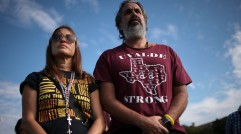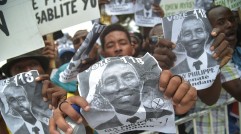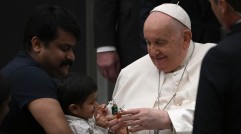UN Climate Summits Prompts People's Climate March, Hundreds Block Wall St.
Protests and a summit around a tricky human 21st century question, "What to do about climate change?", were months in the planning. There was the People's Climate March on Sunday, a civil disobedience staged for Wall Street on Monday, and the penultimate, U.N, Secretary General's specially requested, Climate Summit. All three showed people of all kinds engaged in making it clear that changes to energy policies need to be made.
Organizers of the People's Climate March for Sunday in New York had anticipated 100,000 marchers, but on the day, the numbers quadrupled. People came from Colorado, Detroit, and Ohio, on bikes, in strollers and others in wheelchairs for the three-mile march down Sixth Avenue and along 42nd Street. The messages were unanimous according to slogans on placards -- Wake Up and Smell the CO2, There is no Planet B, and Nature is not a luxury. Sister events in 158 countries took place from Berlin to Istanbul to Rio.
People were realistic; they will make demands of the politicians but they will also make choices about how to live, what to purchase and what to protest, like Madelyn Hoffman from New Jersey Peace Action.
"For every war, and every tank and every soldier, the U.S. military uses so much fossil fuel it has added to the climate change problem. We use more in the process of waging war than we get in return, so it is a net energy loss. We want to see the nation get off oil, and the world and go into renewables. And if we stop the wars we can save those resources too -- human, financial, environmental, all those resources," Hoffman told Latin Post.
The next day, Monday, protesters rallied in their thousands to take direct action by occupying Wall Street or "#FloodingWallStreet" as it was dubbed -- a replica of the effects of Hurricane Sandy in 2013, a continuation of the Occupy protests three year's ago, and a reminder to corporations that they contribute to record pollution rates with its support of the fossil fuel industry.
A rally in Battery Park was followed by a march up the lower part of Broadway towards Wall Street. By the brass Bull, after a mic check announcement, marchers staged a sit-in, halting traffic.
Sarah Redmond had the telephone number of the National Lawyer's Guild written on her arm, preparation for when she would get arrested.
"There are a lot more people here than I thought, but then yesterday there was four times the number of people. I think it is incredible. I think its long, long overdue and it's the only issue anyone should be working on," Redmond told Latin Post. "We came because we're Unitarian Universalists, and we came because our religion tells us that we need to protect the earth, so that's why we came. I have six grandchildren and I want them to have a livable planet, and everyone else's kids. If we are still here, we are probably getting arrested. I am 70 years old I have never been arrested, so I am not looking forward to it."
For the next eight hours, protesters inched their way up to Wall Street where they tried to break through the barricade before police pushed back and a shot of pepper spray was fired into the crowd.
All through the day the police were remarkably restrained, in stark contrast to their actions at Occupy Wall Street three years ago under the Bloomberg administration.
As the light was fading, police gave an order to disperse, an order which the crowd of about 100 responded to by sitting down. Over the next hour police slowly arrested those staging a sit-in. An arrest of a person dressed as a polar bear became the iconic image from the day.
Police have arrested the polar bear #FloodWallStreet pic.twitter.com/jKq7byFUxG
— Jordan Mammo (@jordanmammo) September 22, 2014
The stark contrast between ideas, desires and reality showed on Tuesday at the U.N Climate Summit when world leaders joined civil society organizations, business and financial leaders to present bold and aggressive ideas to fight climate change.
More than 30 countries pledged to end deforestation by restoring one million square miles of forest worldwide by 2030. Joining the pledge were the United States, the entire European Union and Canada.
But Brazilian government officials complained they weren't included in the discussion and said they would not endorse the pledge because the language of the pledge clashed with its national law allowing for the managed felling of the Amazon and other forests. Three Brazilian states, however, did endorse the pledge, showing when ideas get to the policy level, discord can happen. The U.N. said if the goal was met it would be the equivalent of taking every car in the world off the road.
Marshall Islander Kathy Jetnil Kijiner, one of 544 women under the age 30 who applied to represent a developing country at the U.N. Climate Summit, got a standing ovation for her speech and rap to her young son.
"The Marshall Islands encompasses more two million square miles of ocean, so it makes sense our culture is one of voyaging and navigation ... Climate Change is a challenge few want to take on, but the price of inaction is so high, those of us from Oceania are already experiencing it firsthand. We've seen waves crashing in to our homes and seen the breadfruit trees wither from the salt and drought. We look at our children and wonder how they will know themselves or their culture should we lose our islands. Climate change affects not just us islanders; it threatens the whole world," said Kijiner.
New York's Mayor, Bill de Blasio added his plan for New York City.
"So many people who are fighting to save our planet have converged on our city to spark greater action as we saw powerfully at Sunday's march. We know humanity is facing an existential threat, the cause is us -- how we heat our homes, how we transport ourselves, the reckless way in which we live. This is an issue we all face; no one is spared. And our mutual need to survive should instill in us a kind of unity we so rarely experience."
De Blasio said greenhouse gases in the city are down 19 percent since 2005, but he committed to cut greenhouse gases by 80 percent by 2050 and plans to retrofit 3,000 city buildings and work with private building owners on energy conservation plans. It's a bold, aggressive start.
Subscribe to Latin Post!
Sign up for our free newsletter for the Latest coverage!
* This is a contributed article and this content does not necessarily represent the views of latinpost.com













